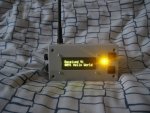This is my take on a Morse decoder based on a 08M2.
It uses a NE567 to detect the Morse tones from the audio input of a radio receiver and converts it into ASCII characters and displays them on a AXE133Y OLED or serial terminal. It will operate from a 5v supply or 3 x AA battery pack.
This is the first part of a portable unit I am building to detect and display Morse audio and data telemetry from a Lost Model Locator based on a Hope RFM42 RF Module.
The document uploaded here contains the description, pretty pictures, circuit diagrams and the code for the 08M2 decoder and AXE133Y OLED.
Thanks go to to M Burnette who authored the magic morse code.
It uses a NE567 to detect the Morse tones from the audio input of a radio receiver and converts it into ASCII characters and displays them on a AXE133Y OLED or serial terminal. It will operate from a 5v supply or 3 x AA battery pack.
This is the first part of a portable unit I am building to detect and display Morse audio and data telemetry from a Lost Model Locator based on a Hope RFM42 RF Module.
The document uploaded here contains the description, pretty pictures, circuit diagrams and the code for the 08M2 decoder and AXE133Y OLED.
Thanks go to to M Burnette who authored the magic morse code.
Attachments
-
373 KB Views: 192

